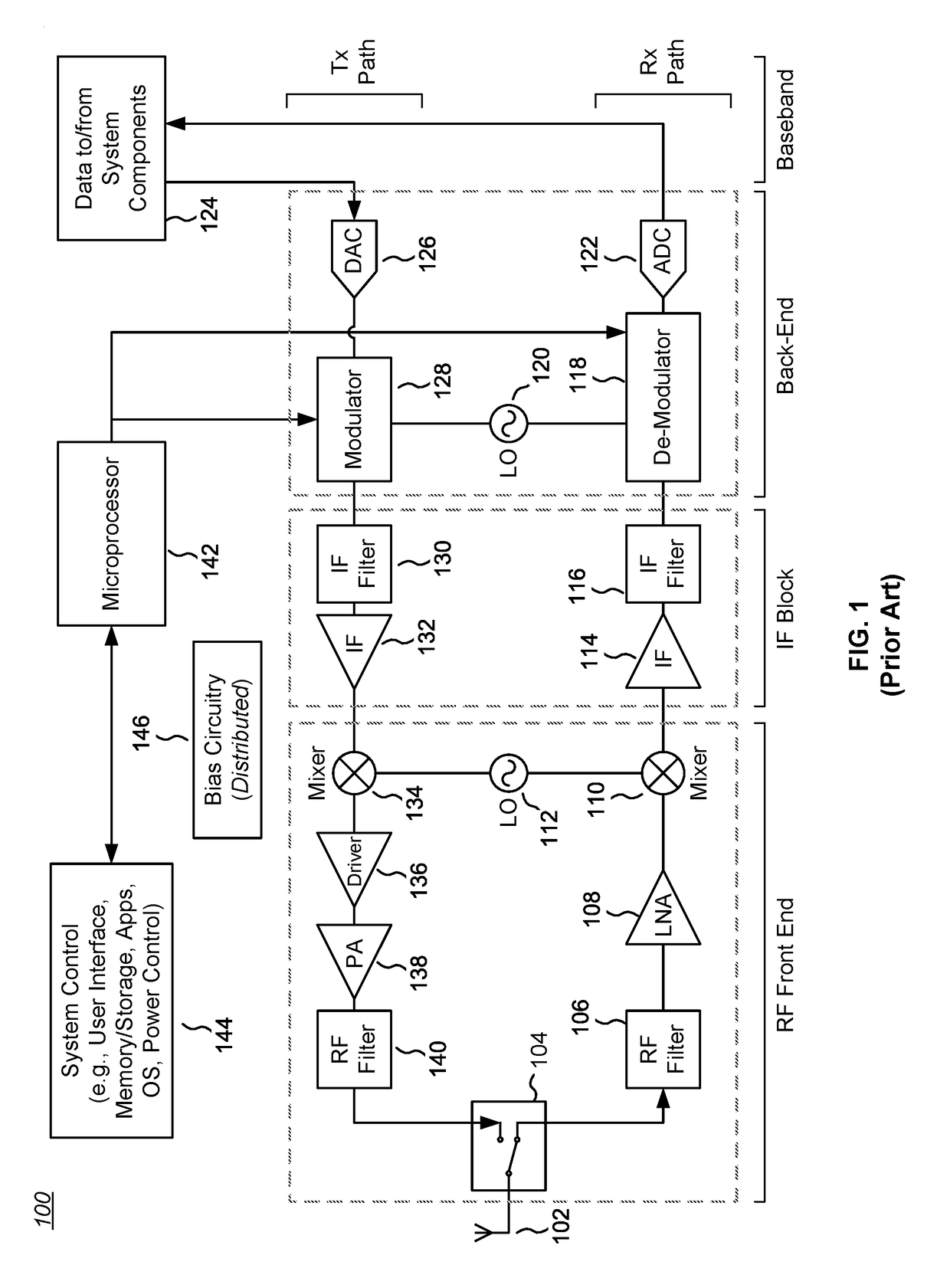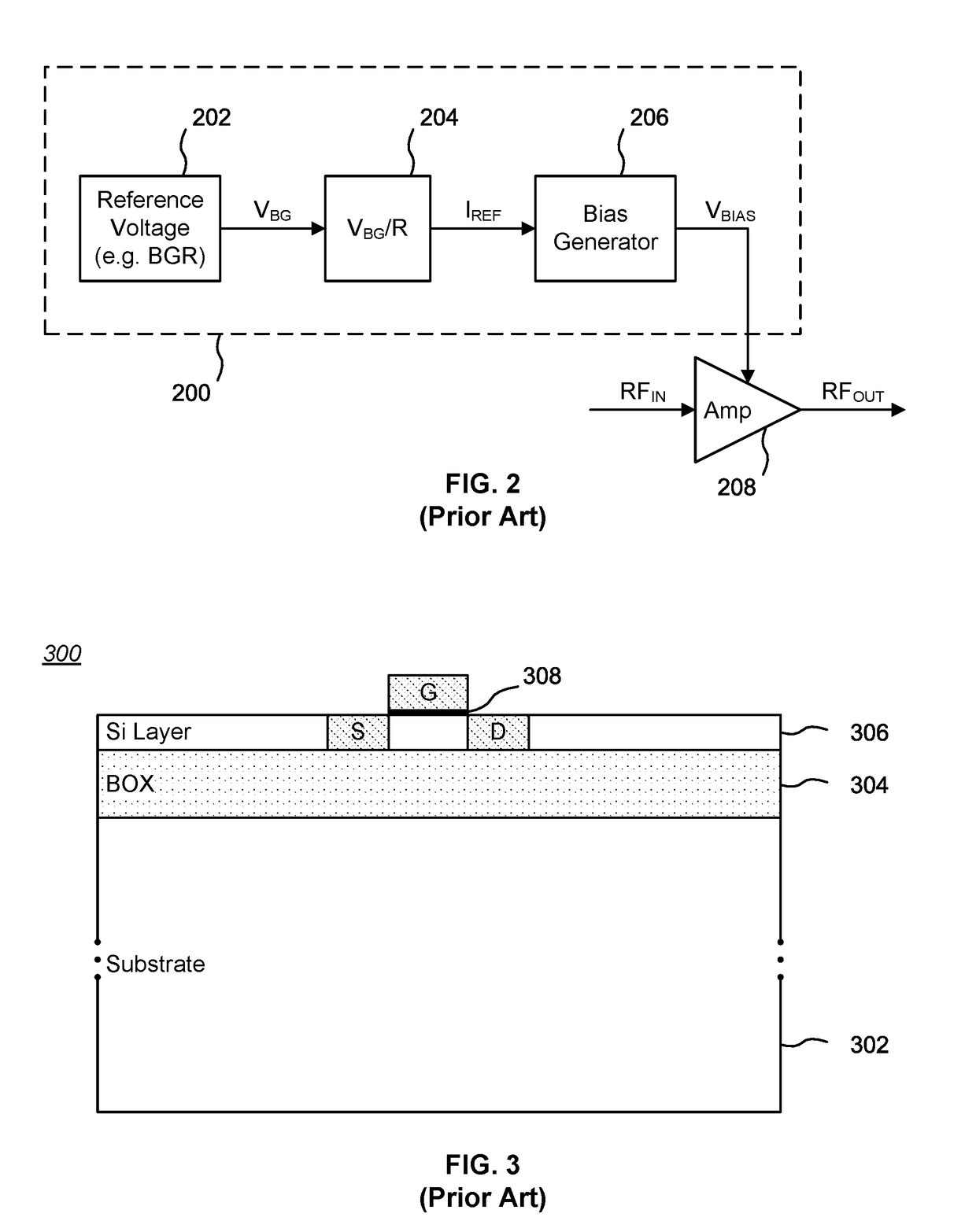Transient Stabilized SOI FETs
a soi fet, transient stabilized technology, applied in the direction of electronic switching, semiconductor/solid-state device details, pulse technique, etc., can solve the problems of complex switching and control, rf design becomes more acute, and difficulty in optimizing operational parameters, so as to achieve stable charge
- Summary
- Abstract
- Description
- Claims
- Application Information
AI Technical Summary
Benefits of technology
Problems solved by technology
Method used
Image
Examples
first embodiment
[0072]FIG. 5A is a schematic diagram of the present invention that stabilizes VDS of a FET when in a standby mode. Shown is a P-type FET M1 coupled between a supply voltage VDD and a controlled through-path switch S1. The gate of M1 is coupled to either a bias voltage VBIAS or to a standby voltage VSB (which may be VDD) through a controlled gate switch S2. As an example, FET M1 may be a component of a power amplifier bias circuit.
[0073]The through-path switch S1 may be switched to connect M1 to either a Load or a “pseudo” load VLOAD. VLOAD may be provided by a voltage supply that is approximately equal to the voltage present on the drain of M1 during active mode operation. FIG. 5B is a schematic of one circuit for generating VLOAD for the circuit of FIG. 5A. In this example, VLOAD is generated by a simple resistive divider circuit comprising resistances R1 and R2 series coupled between VDD and circuit ground. The voltage for VLOAD depends on VDD and the ratio of R1 to R2. Other circ...
second embodiment
[0082]FIG. 6A is a schematic diagram of the present invention that stabilizes VGS of a FET when in a standby mode. Shown is a P-type FET M1 coupled between a supply voltage VDD and a controlled through-path switch S1, which in turn is coupled to a Load. The gate of M1 is coupled to a bias voltage VBIAS. S1 may be implemented as a FET coupled in conventional fashion to function as a single-pole, single throw (SPST) switch. Accordingly, S1 has two binary states, a CLOSED state (as shown in FIG. 6A) and an OPEN state (as shown in FIG. 6B). As an example, FET M1 may be a component of a bias circuit for a power amplifier. Further, other circuitry may be coupled between M1 and VDD and / or between M1 and the Load. An NFET version of the circuit of FIG. 6A would look similar, but “upside down”: S1 and Load would be between VDD and the drain of M1, with the source of the NFET version of M1 coupled to circuit ground, the gate of M1 connected to VBIAS, and the drain of M1 coupled through S1 to ...
third embodiment
[0090]FIG. 7A is a schematic diagram of the present invention that provides a trickle current state for a PFET when in a standby mode. Shown is a P-type FET M1 coupled between a supply voltage VDD and a controlled through-path switch S1. The gate of M1 is coupled to a bias voltage VBIAS. Also coupled to the gate of the M1 PFET is a feedback voltage 702 from the drain of M1 that provides control over the VGS of M1; the feedback voltage 702 may be controlled or modified in some applications by optional circuitry 704 (an example of one such control circuit is shown in FIG. 8). Note that the feedback voltage 702 may be VBIAS; that is, no external bias voltage is applied to the gate of M1, just the feedback voltage 702. As in the above examples, FET M1 may be a component of a power amplifier bias circuit.
[0091]The through-path switch S1 may be switched to connect M1 to either an active mode resistance RL (which may be provided by a Load) or a standby mode resistance RSB. As in the embodi...
PUM
 Login to View More
Login to View More Abstract
Description
Claims
Application Information
 Login to View More
Login to View More - R&D
- Intellectual Property
- Life Sciences
- Materials
- Tech Scout
- Unparalleled Data Quality
- Higher Quality Content
- 60% Fewer Hallucinations
Browse by: Latest US Patents, China's latest patents, Technical Efficacy Thesaurus, Application Domain, Technology Topic, Popular Technical Reports.
© 2025 PatSnap. All rights reserved.Legal|Privacy policy|Modern Slavery Act Transparency Statement|Sitemap|About US| Contact US: help@patsnap.com



